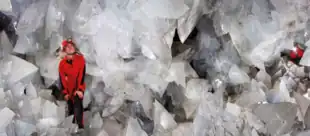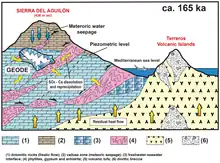Pulpí Geode
The Pulpí Geode (Spanish: Geoda de Pulpí) is a giant geode found in Spain near the town of Pulpí (Province of Almería) in December 1999,[1][2] by Javier Garcia-Guinea of the Grupo Mineralogista de Madrid. This geode is one of the largest documented geodes in the world to date. It occupies a space of 10.7 cubic metres (380 cu ft), measuring 8 by 1.8 metres (26.2 by 5.9 ft) with an average height of 1.7 metres (5 ft 7 in), and is located at a depth of 50 metres (160 ft) in the Pilar de Jaravía mine, in the Sierra del Aguilón, in the municipality of Pulpí, 3 kilometres (1.9 mi) from the coast.

The geode has a funnel shape, with the narrowest part being L-shaped. It is notable on a worldwide scale for both its size and the transparency and perfection of the selenite (gypsum) crystals lining the interior, which reach up to 2 metres (6 ft 7 in) in length, with 50 centimetres (20 in) being the average. The abandoned silver-lead mine is now a geoheritage site attracting geotourists. The geode was damaged by vandals at the end of 2021,[3] but the damage was not as severe as first thought.[4]

The latest scientific research, on the origin of the geode, was published on 23 March 2022; the research was led by Fernando Gázquez of the University of Almeria, with the conclusion that the gypsum crystals were formed between 164 ± 15 thousand and 60 thousand years ago, in the upper Pleistocene, from a freshwater aquifer (with very little evidence of brackish or sea water, as suggested previously).[5]
References
- Robin George Andrews (22 October 2019). "These human-size crystals formed in especially strange ways". National Geographic. Retrieved 4 January 2023.
- Canals, A.; Van Driessche, A.E.S.; Palero, F.; García-Ruiz, J.M. (2019). "The origin of large gypsum crystals in the Geode of Pulpí (Almería, Spain)". Geology. 47 (12): 1161–1165. Bibcode:2019Geo....47.1161C. doi:10.1130/G46734.1. hdl:10481/58623. S2CID 204972371.
- Linda Hall (20 February 2022). "Pulpi's geode damaged by unauthorised visit". Euro Weekly News. Retrieved 4 January 2023.
- Linda Hall (24 February 2022). "Pulpi's Geoda hardly damaged despite uninvited guests". Euro Weekly News. Retrieved 4 January 2023.
- Gázquez, Fernando; Monteserín, Ana; Obert, Christina; Münker, Carsten; Fernández-Cortés, Ángel; Calaforra, José María (2022). "The Absolute Age and Origin of the Giant Gypsum Geode of Pulpí (Almería, SE Spain)". Geosciences. 12 (4): 144. Bibcode:2022Geosc..12..144G. doi:10.3390/geosciences12040144.
External links
- The Pulpí gigantic geode (Almería, Spain): geology, metal pollution, microclimatology, and conservation
- Pilar de Jaravía; La geoda gigante de la Mina Rica (in Spanish)
- La Geoda de Pulpí website: https://www.geodapulpi.es/